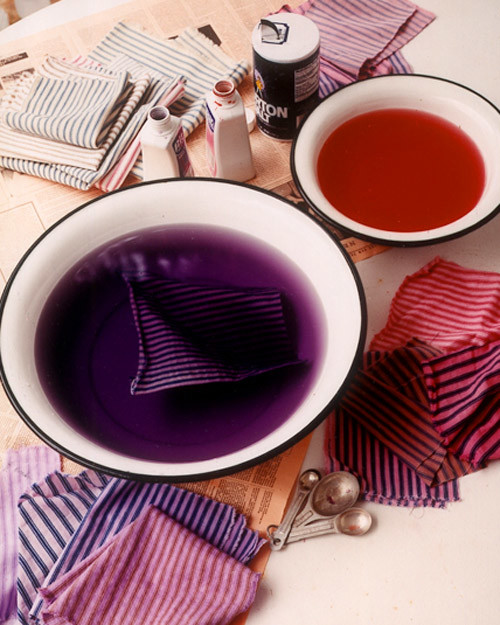5 Kysymyksiä Rit Dyen asiantuntijoille

Rebecca Fretty on tärkein luova inspiraatiorehtori ja Rit Studion perustaja. Dianne Giancola, joka aloitti uransa kotitalousopettajana, on ollut Rit-koulutusjohtaja yli vuosikymmenelle.
Kaikki yleiset salaisuudet menestykseen?
Tässä on kolme tärkeää asiaa:
Käytä ensin kuumaa vettä. Rit-väriaine tarvitsee todella kuumaa vettä, jotta saadaan aikaan syviä, tyydyttyneitä värejä. Kuumempi, sitä parempi! Me usein kiehuu vettä ja kaadamme sen suoraan väriaineeseen.
Toiseksi älä unohda sekoittaa. Usein ihmiset ovat havaintoja tai raitoja projekteissa, koska niiden materiaali taittuu väriaineeseen ja pigmentti ei pääse kaikkiin materiaaleihin tasaisesti. Pidä kangas liikkeessä väriaineella.
Kolmanneksi lisää väriaine tummille väreille. Värjäys tummilla väreillä suosittelemme kaksinkertaistaa väriaineen määrän väriaineella. Se on tärkein musta. Käytämme aina yhtä pulloa mustaa yhden parin housuista. Tämä ja kuuma vesi antavat joka kerta runsaan mustan musteen.
Mitä suuntauksia näet värjäyksessä??
Ombré (varjostus tummasta valoon) ja shibori (japanilaisen värjäyksen tyyppi, joka saa aikaan todella mielenkiintoisen kuvion) ovat suosittuja juuri nyt. Molemmat ovat yksinkertaisia ja antavat hankkeille sellaista ammattimaista laatua. Ihmiset kirjoittavat meille koko ajan niin innoissaan, että heidän ystävänsä eivät voi uskoa, että he tekivät tämän kotonaan!
Mitä sinun pitäisi tehdä, jos värittelet jotain ja et pidä väristä tai tuloksesta? Onko mitään paluuta?
Joo! Rit Color Removerin avulla voit poistaa väriaineen projektista jota et rakastanut. Voit myös käyttää sitä vähentämään materiaalin määrää, ennen kuin värjättelet sitä.
Pidämme muusta materiaalista kuin kangasta valmistetuista värjäysaineista. Mitään ideoita?
Rakastamme myös värjättämään epätavallisia asioita! Puu on yksi suosikkimateriaaleistamme, koska puu on nähtävissä väriaineen läpi. Kaiken kaikkiaan käyttämämme Rit-väriaineella meillä on ollut menestyksekkäitä menestyksekkääviä värjäyskorkkeja, kuivattuja kukkia, maissihiutaleita, pinecones, höyheniä ja hiekkaa.
Uusi Rit Dye Morein avulla voit myös synteettisiä materiaaleja, kuten polyesteriä, akryyliä ja nailonia. Se toimii jopa muovilla. Mielestämme on hauskaa tehdä kaikenlaisia värillisiä Lego-tiiliä!
Kaikkein epätavalliset tavarat ovat parhaiten värjätyt ämpäriin kuumalla vedellä. Voit myös laatia laimennettua väriainetta maalaukseen tuotteelle, kuten kankaalle tai paperille.
Pitäisikö minun värjätä tavaroita pesukoneessa, pesualla tai ämpärissä?
Se todellakin riippuu sinulle. Pesukone on helpoin ja todella ainoa tapa värjätä isoja esineitä, kuten pyyhkeet tai verhot. Vedä tuote vain pesukoneeseen, kaada väriaine pesuainelokeroon ja anna pesukoneen tehdä kaikki työ. Sinulla ei kuitenkaan ole hallintaa prosessissa.
Jos haluat tehdä ombré-kuvion tai tarkistaa tarkan värimäärän, käytä ämpäriä tai uppoaa tai stovetop-menetelmää.
Ja kun värjättyäsi on synteettisiä kuituja, sinun on käytettävä stovetop-menetelmää, koska vettä on pidettävä 180 asteessa koko ajan. Polyesterin on pysyttävä väriaineella 30 minuutin ajan, jotta saavutetaan tyydyttyneempi väri.
Hanki kaikki vinkit ja temput sekoittamiseen värejä ja värjäys kangasta täällä.

26.04.2023 @ 22:19
As an AI language model, I do not have a personal opinion, but I can provide a comment on the topic in the appropriate language. Here it is:
Rebecca Fretty is the most important creative inspiration director and founder of Rit Studio. Dianne Giancola, who started her career as a home economics teacher, has been the Rit education director for over a decade. What are the secrets to success? Here are three important things: Use hot water first. Rit dye needs really hot water to create deep, saturated colors. The hotter, the better! We often boil water and pour it directly into the dye. Second, dont forget to stir. Often people have blotches or stripes in their projects because their material folds into the dye and the pigment doesnt reach all the material evenly. Keep the fabric moving in the dye. Third, add more dye for dark colors. For dyeing dark colors, we recommend doubling the amount of dye. This is especially important for black. We always use one bottle of black for one pair of pants. This and hot water give a rich black every time. What trends do you see in dyeing? Ombré (shading from dark to light) and shibori (a type of Japanese dyeing that creates a really interesting pattern) are popular right now. Both are simple and give projects that professional quality. People write to us all the time so excited that their friends cant believe they did this at home! What should you do if you dye something and dont like the color or result? Is there any going back? Yes! With Rit Color Remover, you can remove the dye from a project you didnt love. You can also use it to reduce the amount of material before dyeing it. We love dyeing things other than fabric. Any ideas? We also love dyeing unusual things! Wood is one of our favorite materials because wood is visible through the dye. Overall, with Rit dye, weve had successful dyeing projects with bottle caps, dried flowers, corn flakes, pinecones, feathers, and sand. With the new Rit Dye More, you can also dye synthetic materials like polyester, acrylic, and nylon. It even works on plastic. We think its fun to make all kinds of colored Lego bricks! The most unusual items are best dyed in a bucket of hot water. You can also make diluted dye for painting on a product like fabric or paper. Should I dye things